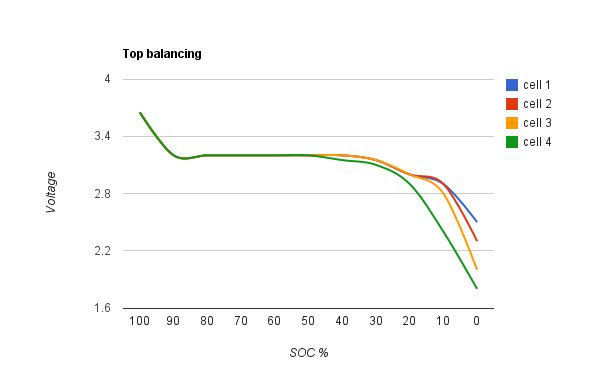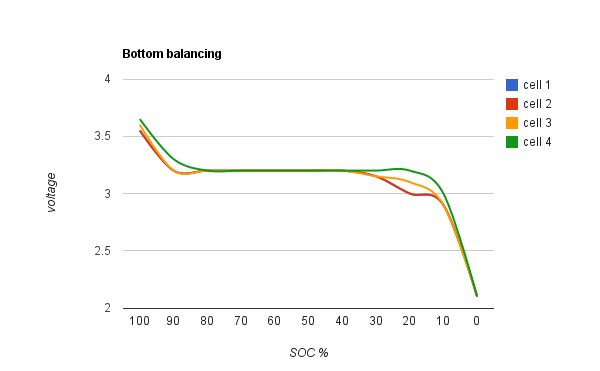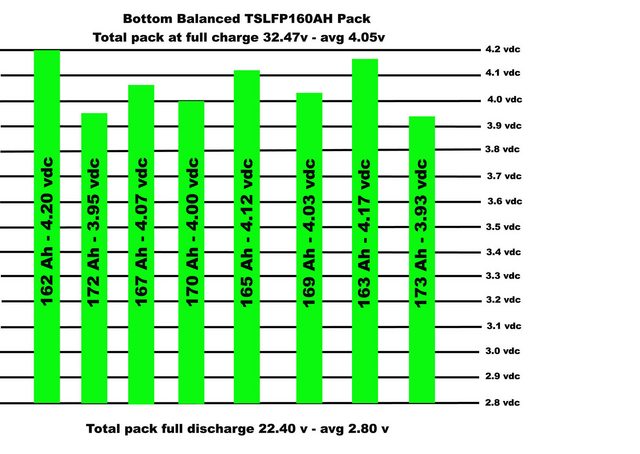The Mighty Volt
1 MW
Those are largely my observations Gary, regarding the voltages of old vs new cells.
I like Jack but I don't understand where he gets his information or if he just likes being the antagonist. Jack told me that the C rating on a discharge doesn't matter when you are using lifepo4 and that is not true at all. That's what made me stop listening to Jack Rickard. He said you could use a 5 C discharge on a Thundersky battery rated at 2C and it wouldn't hurt the battery as long as you didn't run it to the "knee" of the charge curve.
The "bottom balancing" idea only works if all the cells are exactly the same capacity, which is quite unlikely. Even really good quality cells, like A123s, will probably have a 5% or so capacity variation from one cell to another. If you discharge all the cells in a pack to the same low voltage, then one or two will reach full charge before the rest. If you carry on charging, these cells will get over-charged, whilst the bigger capacity cells in the pack play catch up. All told, this is a fairly dumb idea, in my personal view. It's far better to control each cell to a fixed voltage, as that way the cell capacity tolerances don't matter (apart from the pack usable capacity being set by that of the lowest capacity cell, as you'd expect with any battery).




"Jay Whitacre, a Carnegie Mellon professor with a joint appointment in Materials Science and Engineering and Public Policy, gives a quick overview of Lithium-ion batteries. Starting at the chemical level, he explains the properties and mechanics of the battery which give rise to macroscopic behavior"
The 'theory of bottom balancing' was presented by someone that didn't know...jack...about cells and balancing in the real world
The points that immediately jump out at me so far is that 'many' people are not anti-BMS, and those that are seem to be either refugees from the $12 'planned obsolescence' devices or are still hanging on to the persuasive pitch from a battery beginner.
Bottom balancing gets us close to 'balanced' only at the time it's performed - just as a stopped clock is only right twice each day.
Not sure why you'd want to bottom balance.
Cells are of varying mAh and discharge rates, and will have natural variances, just by nature.
That is why cell voltages start to rapidly differ at the end of the charge.
The difference is, if you top balance, you spend that available capacity with more time spent at a higher SOC, meaning lower average internal resistance, and higher average voltage (though with LiFePO4 that's almost a non-factor).
liveforphysics said:Many packs run no BMS because the cells don't need it.
All the Mn spinel stuff, (kinions, Emoli, LG, etc) have a decreased nesting efficiency as the SOC nears full. This functions as a natural passive balancing mechanism. It's how Doc Bass, JohnCR, and many others keep perfect balance packs doing nothing but bulk charging.
For typical lithium ion:
In normal charging, about 60% of lithium in the cathode active substance is extracted, and is doped into the carbon in the anode. As a result, the cathode active substance becomes Li1-x CoO2 (x≈0.6), but when overcharged, the remaining lithium is further extracted, and the lithium extracted in overcharging precipitates on the surface of the anode as metal lithium. This metal lithium precipitating on the anode surface is extremely active, and it violently reacts with electrolyte, possibly causing thermal runaway, and safety in overcharging is uncertain.
On the other hand, when lithium manganese complex oxide (LiMn2 O4, etc.) is used in the cathode, in normal charge-discharge reaction, the following reactions (5) and (6) take place. That is, in normal charging, almost all lithium in the cathode is extracted and doped into the anode carbon, if overcharged, there is no longer any remaining lithium to move from the cathode to the anode. Therefore, if overcharged, metal lithium does not deposit on the anode, and safety in overcharging is guaranteed.
docnjoj said:Bosch Fatpacks with Konions used to be a bargain at 45 bucks apiece delivered and would qualify for your "ideal self balancing battery", Auraslip. Now they are about $100 for the same 36 volt 2ah pack. Not such a great deal anymore. Still great cells though! Doc Bass sells them as individual cells from Makita packs (slightly different cell but similar)!
otherDoc
icecube57 said:I have turnigy Lipos. I drug them to the true 105% discharge. The voltages were all over the place but the voltages were still in the safe zone. I had up to 35mv of deviation. I put them on the charger and within 2-3 minutes they were all at the same voltage. They all terminated at the same voltage and were in balance. So to me bottom balancing is useless it just creates a pain in the ass on the top end because they will be out of balance because obviously the cells have different capacity therefor different votlages when full dischaged.
